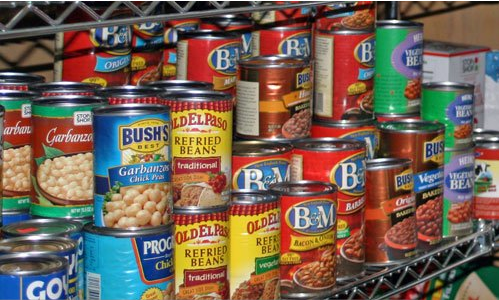BARRE – A new study by the Vermont Foodbank and Feeding America shows that 1 in 4 people, or an estimated 153,100 people, in Vermont turn to food shelves and meal service programs to feed themselves and their families. This includes 33,900 children and 26,010 seniors.
The Hunger in America 2014 local findings show that 18,700 people are served each week by programs supported through the Vermont Foodbank. Accounting for multiple program visits, clients turned to the Vermont Foodbank’s network partners 1.2 million times over the course of the year. This means clients are visiting the Foodbank’s network programs an average of 8.3 times a year.
Nationally, Hunger in America 2014 found that more than 46 million people turn to agencies and programs of the Feeding America network of food banks every year. The Vermont Foodbank has been a member of the Feeding America network since 1994.
The study documents household demographics and offers a snapshot of the people served by the Vermont Foodbank – their circumstances, the challenges they face and the choices they are forced to make living on extremely limited household incomes. It is also the first nationally-representative study that assesses the prevalence of past and current members of the U.S. Military and adult students receiving charitable food assistance.
“The results of this study show us that the face of hunger is one we might recognize,” said John Sayles. “Many of our neighbors who are seeking food assistance have jobs, raise families, work toward education and struggle with health problems, like all of us. Too often, our clients also have to make difficult trade-offs to get enough food for their families. As we look ahead to Hunger Action Month this September, it is important to remember the critical work the Foodbank does every day, and how much more we can do together to solve hunger in Vermont.”
“The Hunger in America 2014 findings demonstrate the urgent need for all of us to address hunger in our communities,” said Bob Aiken, CEO of Feeding America. “This data provides a factual basis for decisions about how we as a nation approach hunger relief and protect our most vulnerable citizens.”
Key statistics from the report include:
WIDESPREAD — USE OF FOOD ASSISTANCE [FOR EACH STAT YOU CHOOSE TO — USE, CONSIDER HIGHTLIGHTING A COMPARISON TO THE NATIONAL AVERAGE IF IT TELLS A COMPELLING STORY
The Vermont Foodbank serves 153,100 people annually, including 33,900 children.
7.8% percent of adult clients are students.
18 percent of households include someone who is a veteran or who has ever served in the military.
35.8 percent of the Foodbank’s network partners employ no paid staff/are operated exclusively by volunteers.
CLIENTS STRUGGLING WITH HEALTH ISSUES
71.8 percent of households report purchasing inexpensive, unhealthy food because they could not afford healthier options.
56 percent of households report having to choose between paying for food and paying for medicine or medical care.
23 percent of households include a member with diabetes.
46 percent households have a member with high blood pressure.
MAKING TOUGH CHOICES AND TRADE-OFFS TO KEEP FOOD ON THE TABLE
Following are the choices client households reported making in the past 12 months:
63 percent report choosing between paying for food and paying for utilities.
21 percent of these households are making the choice every month.
58 percent report making choices between paying for food and paying for transportation.
22 percent of these households are making the choice every month.
56 percent report choosing between paying for food and paying for medicine/medical care.
23 percent of these households are making the choice every month.
52 percent report choosing between paying for food and paying for housing.
17 percent of these households are making the choice every month.
20 percent report choosing between paying for food and paying for education expenses.
9 percent are making the choice every month.
More than half (53.9%) of households reported using three or more coping strategies for getting enough food in the past 12 months. The frequency of these strategies among all households include:
52.6 percent report eating food past the expiration date;
36.4 percent report growing food in a garden;
25.3 percent report pawning or selling personal property;
71.8 percent report purchasing inexpensive, unhealthy food;
31 percent report watering down food or drinks;
53.4 percent report receiving help from friends or family.
LOW WAGES, UNDEREMPLOYMENT AND UNEMPLOYMENT DRIVING NEED
7.5 percent of respondents have faced foreclosure or eviction in the past five years.
Among all households served by the Vermont Foodbank’s network partners, 60.2 percent have at least one member who has been employed in the past year.
Among all households with an employed person, the person with the longest employment duration is more likely to be employed part-time (85.5 percent) than full-time (14.5 percent).
Hunger in America 2014 was conducted using rigorous academic research standards and was peer reviewed by a technical advisory team including researchers from American University, University of Illinois at Champaign-Urbana and the Urban Institute. Nationally, confidential responses were collected on electronic tablets by 6,000 trained volunteer data collectors.
The study was funded by The Howard G. Buffett Foundation




